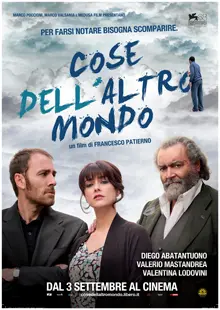

We are in an anonymous and working center of the Northeast, full of immigrants who have a significant impact on the local economic fabric.
Mariso Golfetto is a somewhat vulgar and racist industrialist, who gives work to lots of immigrants through his company and at home. For the Venetian industrial setting, the offices and warehouses (as well as thirty or so employees, used as extras) of Came, an automatic gate company in Dosson, a district of Casier in Treviso, was used.
Golfetto, who doesn’t hesitate in enjoying the company of a Nigerian prostitute, uses his private TV station (the studios used are those of LA9 in Villorba) to complain about immigrants in his spare time.
Then one of his malicious wishes is granted and the next day, following a violent storm (created entirely using 3D computer graphics), all the immigrants disappear. This absence soon turns into a presence: Golfetto soon realises that there are traces of the immigrants everywhere, in the businesses left at a standstill for a lack of staff, in the empty seats at school, in the dirty dishes and laundry waiting to be taken care of in people’s homes, in the heaps of rubbish piling up on the streets that no one’s bothered to pick up. Lots of scenes were filmed in the historic centre of Bassano del Grappa (VI) and the G. Mazzini school, where Laura teaches (also in Bassano).
Realising that the immigrants are essential to keep things moving, Golfetto looks at various strategies, even hiring an unlikely wizard who promises to solve the problem by reciting spells during the mid-Lent ‘brusa la vecia’ celebrations held to drive away the cold season and usher in Spring, reconstructed (out of season) in Casier on the banks of the River Sile.
We are in an anonymous and working center of the Northeast, full of immigrants who have a significant impact on the local economic fabric.
Mariso Golfetto is a somewhat vulgar and racist industrialist, who gives work to lots of immigrants through his company and at home. For the Venetian industrial setting, the offices and warehouses (as well as thirty or so employees, used as extras) of Came, an automatic gate company in Dosson, a district of Casier in Treviso, was used.
Golfetto, who doesn’t hesitate in enjoying the company of a Nigerian prostitute, uses his private TV station (the studios used are those of LA9 in Villorba) to complain about immigrants in his spare time.
Then one of his malicious wishes is granted and the next day, following a violent storm (created entirely using 3D computer graphics), all the immigrants disappear. This absence soon turns into a presence: Golfetto soon realises that there are traces of the immigrants everywhere, in the businesses left at a standstill for a lack of staff, in the empty seats at school, in the dirty dishes and laundry waiting to be taken care of in people’s homes, in the heaps of rubbish piling up on the streets that no one’s bothered to pick up. Lots of scenes were filmed in the historic centre of Bassano del Grappa (VI) and the G. Mazzini school, where Laura teaches (also in Bassano).
Realising that the immigrants are essential to keep things moving, Golfetto looks at various strategies, even hiring an unlikely wizard who promises to solve the problem by reciting spells during the mid-Lent ‘brusa la vecia’ celebrations held to drive away the cold season and usher in Spring, reconstructed (out of season) in Casier on the banks of the River Sile.

In a city in the North-East, where immigration has a strong impact on the social fabric, in the wake of a violent storm all the immigrants vanish.